This seasonal road (mostly gravel) runs 108 miles between Dawson City Yukon and Chicken Alaska on the top of the mountains. The drive winds through pristine wilderness with views of mountain tops and valleys along either side of the road that go on for over 100 miles some of which are still snow covered. It seems to go on forever.  Midway through the trip you cross from Yukon Territory Canada into Alaska at a part time border crossing. The crossing is only open 12 hours a day during the summer months.
Midway through the trip you cross from Yukon Territory Canada into Alaska at a part time border crossing. The crossing is only open 12 hours a day during the summer months.
Days ago we heard our first stories about the road construction on the US side. One visitor center specialist put it in perspective by saying “no has been pulled out by a Euc(earthmover) yet”. They can still say that, BUT it was 13 miles of driving on road base on the US side  with survey sticks down the center and edge of the road sticking up between 1 inch and 2 ft depending on how much they need to add before they install gravel. They use 1 to 6 inch crushed stone for base so for a while it was rough and tedious for our travel. I really had to feel for the motorcycles and bicycles we met trying to bump on through without taking a spill. We finished the construction portion and stopped for the night at a BLM campground about 15 miles short of Chicken Alaska, 93 miles in 5 hours and worth every minute of it.
with survey sticks down the center and edge of the road sticking up between 1 inch and 2 ft depending on how much they need to add before they install gravel. They use 1 to 6 inch crushed stone for base so for a while it was rough and tedious for our travel. I really had to feel for the motorcycles and bicycles we met trying to bump on through without taking a spill. We finished the construction portion and stopped for the night at a BLM campground about 15 miles short of Chicken Alaska, 93 miles in 5 hours and worth every minute of it.





